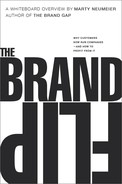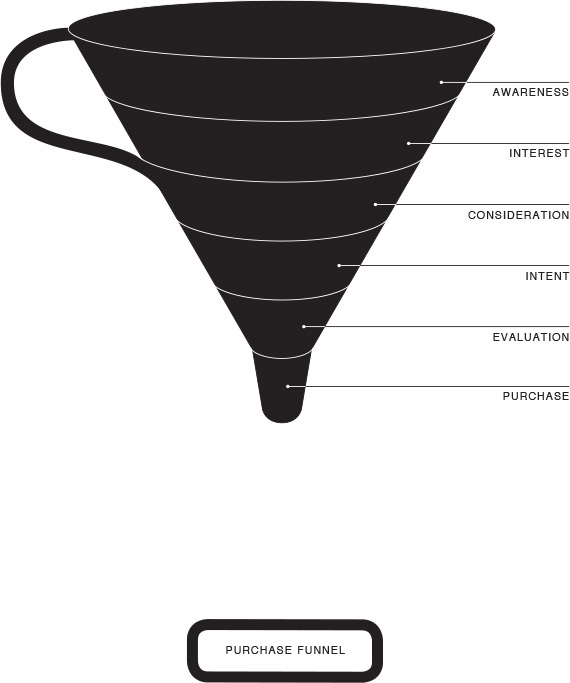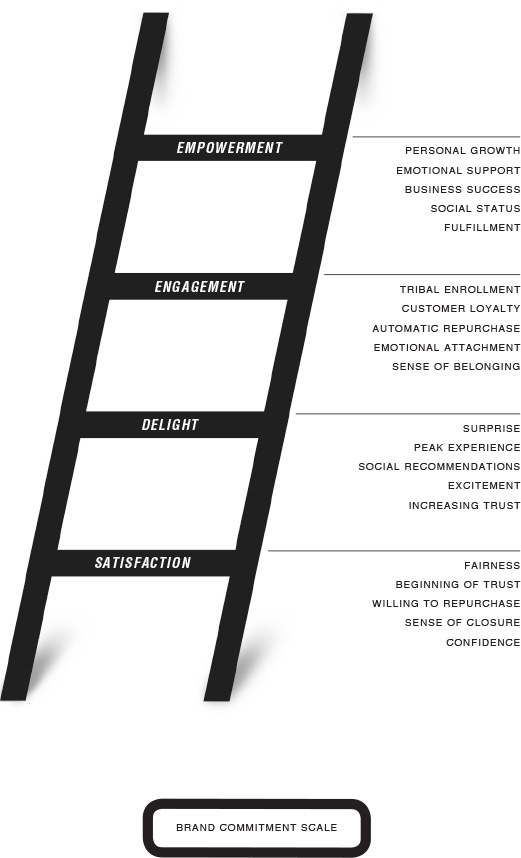PURCHASE FUNNEL  BRAND LADDER
BRAND LADDER
In the pre-flip days of marketing, the important number to watch was sales. Not just current sales, but projected sales, which you could estimate by tracking customers as they moved from awareness to interest to consideration to intent to evaluation and, finally, to purchase. Over time, you could see that a certain percentage of people from each stage would move to the next, until a very small percentage would drop into the bucket as sales.
This model of measurement, called the PURCHASE FUNNEL, is only helpful if 1) your main goal is to project sales in the short term, 2) customers move toward their purchase in predictable stages, 3) current revenues are more important than brand- building, 4) acquiring customers is more important than keeping them, 5) or you have no use for non-customers. There are a lot of ifs here, most of which no longer pan out.
For example, in a time of accelerating change, short-term revenues don’t predict long-term or even medium-term success.
Furthermore, customers no longer purchase in predictable stages. On today’s e-commerce websites, all the stages of the sales funnel can reside in the same place: you can see a product for the first time, consider it, read customer comments, and make your purchase—all without leaving the site. To the customer, there is no funnel. The path from awareness to purchase is nonlinear and immediate.
The funnel image is wrong from a company perspective, too. Instead of stuffing people into a funnel to squeeze out profits, companies should be empowering customers so they can help build the brand. This is not to say that monthly and quarterly revenues are not important. Just that monthly and quarterly revenues are more sizable, more profitable, and more dependable when you focus on longterm relationships instead of short-term revenues.
Marketers need to set aside the funnel and pick up the ladder. The Brand Commitment Scale (BCS), or customer ladder, is a simple tool for measuring the progress of a brand from customer satisfaction to customer empowerment. The BCS puts the emphasis where it belongs—on the customer. It offers a clear metric as to how a company is doing at each level. The object is to get as many customers as possible up the ladder to the top.
Here’s how it works. The bottom rung represents customer satisfaction. This is where trust begins. The customer has tried your product or service and found it to be as advertised. This may be a function of selling a good product, or setting modest expectations, or both. The J. D. Powers surveys are well-known examples of this metric. While satisfaction is a good sign, studies have shown that satisfaction alone is not a reliable predictor of repurchase behavior or customer loyalty.
The next rung up is customer delight. Here’s where trust really catches fire. If you can surprise your customer with something more than baseline satisfaction, you’ll spark the kind of emotion that leads to loyalty. This is the realm of great customer experience. Forrester Research measures delight with its Customer Experience Index, and so does Bain & Company with its Net Promoter Score. Delight is the leading cause of a customer’s “willingness to recommend.”
One level higher is customer engagement. When a customer is truly engaged with a brand, he or she enrolls in the tribe. With membership comes increasing loyalty, escalating repurchase habits, and an emotional attachment that goes far beyond patronage. This is where the brand becomes a building block in the customer’s identity, success, well-being, and even fulfillment. Havas’s Meaningful Brands Index (MBi) has shown that top brands in this metric outperform the stock market by 120 percent.
On the top rung is customer empowerment. This is the level at which customers incorporate your brand into the deepest part of their lives. They may depend on it for emotional support, social status, personal growth, or even business success. They would no more switch to another brand than swap their right leg for a wooden peg. If you suddenly pulled your brand out from under them, they would collapse in a heap.
Empowered customers will move heaven and earth to ensure your success, happily attracting others to the tribe with their magnetic sense of commitment. One measure of this commitment is the Stengel 50. Developed by former P&G marketer Jim Stengel along with Millward Brown Optimor, it’s a list of 50 brands with the deepest customer relationships. A 10-year investment in these brands would have generated 400 percent higher returns than the S&P 500.
The Brand Commitment Scale is an easy-to-use survey that yields a single number from 20–100. This score represents your overall progress up the brand ladder, where empowerment is given four times the weight of satisfaction. If conducted annually, the BCS can highlight your gains (or losses), suggesting where you need more investment. It can also let you compare the scores at each rung of the ladder, and for each of the eight questions.
The power of this survey lies in its simplicity. All it takes is a service like Zoomerang or Survey-Monkey and a little of your customers’ time. A sample of 1,000 surveys should be enough for most companies to get a useful reading.
Using the brand ladder, let’s imagine the progress of Lori’s brand over five years. From the very start, Koko Maya was a critical success. The product and its presentation were good enough to deliver more than satisfaction. It made a strong showing in customer delight, the second rung of the ladder.
In the first year, Lori introduced website features such as What’s Cooking (tips and recipes for moms) and Koko’s Korner (puzzles and projects for kids), which became popular forums for a wide range of conversations. Two years later she developed a successful model for putting on school fundraisers, giving moms a clear role in community involvement. In the meantime, revenues from the website and retailers had climbed to $15 million, and customers had climbed to the third rung of the brand ladder.
The company made steady gains over the next two years, bringing Lori to national attention through major articles in FAST COMPANY, FORBES, and VOGUE. The BBC then made a short documentary on the company and aired it worldwide. Riding this wave of public attention, she was able to persuade the Girl Scouts to retire their calorie-filled cookies in favor of Koko Maya Tea Biscuits. Profits grew 50 percent that year, validating the move and sending Koko Maya’s brand to new heights.
The company then began training “certified tea caterers,” customers who could host in-home tea parties. They became independent business owners, taking on gigs as their schedules permitted. A new army of empowered customers moved the brand up to the fourth rung of the ladder.
During the following decade, the company grew at a much faster rate than expected, thanks to a committed tribe of customers. Lori wrote a memoir, called THE MONKEY TREE, which was named “best business book of the year” by Amazon. She had been spending more and more time in Guatemala, a country she had come to love. Finally, after 15 years in the business she decided to retire there.
That same year the company generated more than $1.5 billion in sales. It counted more than two million people as customers. It supported 3,600 employees and freelance caterers. And it touched families in 47 countries around the world. Not bad for a “nothing” little product like tea.
While Lori’s story is made up, it demonstrates how companies can flip their brands into a new state—one that generates more value by handing more control to customers. It questions the belief that business is a zero-sum game in which customers must lose so the company can win. And it shows that the brand is only as strong as its tribe.
Of course, brands are only a small part of our lives. We care much more about our families, friends, pets, neighborhoods, careers, health, and just having a good time. But that doesn’t mean a brand can’t play a powerful, profitable role in these things. You just need to flip your thinking: A brand isn’t what YOU say it is; it’s what THEY say it is.
And what THEY say can make all the difference.



